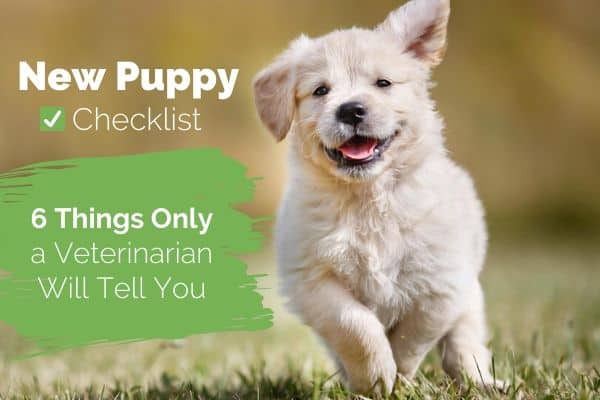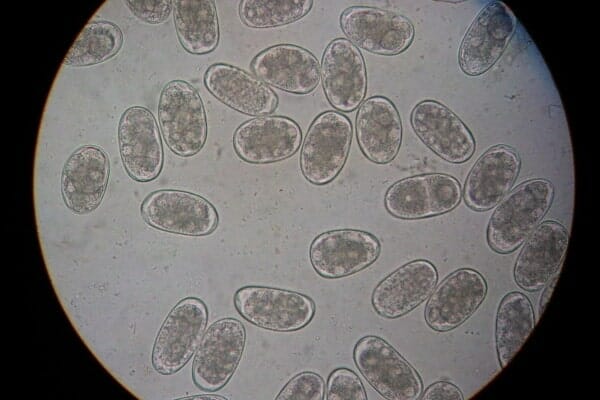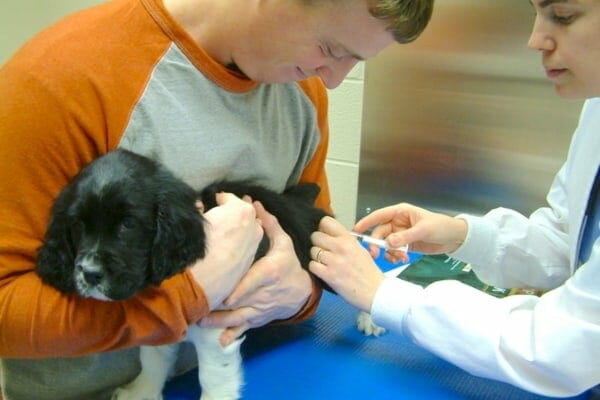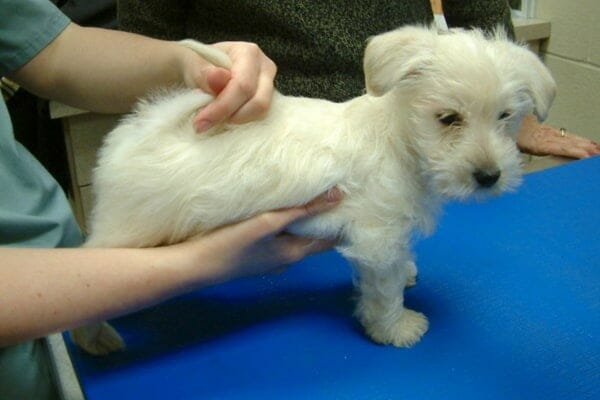
All senior dogs start as puppies. That’s why Dr. Julie Buzby, integrative veterinarian and founder of Dr. Buzby’s ToeGrips®, shares the importance of starting your puppy off with a veterinarian’s take on the new puppy checklist. Over the course of 23 years, Dr. Buzby has cared for a lot of senior dogs who started out as tiny puppies, grew into adults, enjoyed many senior years, and then crossed the Rainbow Bridge. In the circle of life—when those families’ broken hearts begin to heal—she then had the pleasure of meeting their new puppies. Her gift to them, and to you, is her new puppy checklist. May it help you and your puppy enjoy the journey to senior dog status.
Although it’s not a headline in the mainstream media, COVID has brought big news for dog lovers. Vets across America are experiencing puppy palooza—tiny balls of fur with names like Rona, Covie, and Quarantina. It seems that current conditions have caused people to stock up on more than just toilet paper.
So if you’re reading this blog as the owner of a senior dog and a new puppy, I see you.
If you’re reading this blog in a state of bereavement and considering a new puppy, I see you.
And if you fit in neither of those categories, but know your future probably holds a puppy, I see you, too.
With all the excitement around puppies, I want to give you a new kind of puppy checklist — one that goes beyond chew toys, dog beds, and puppy food. I want to share six things you need to know that only a veterinarian will tell you.

If you do these six things, you can be sure you will welcome your puppy home with knowledge, a plan, and piece of mind. Plus, your new four-legged friend will forever be thankful.
1. Do your puppy due diligence.
Peter Rabbit was the pride and joy of Misty and Bob Santoro. They rescued the bunny at our county fair, but he was fraught with health issues from the beginning.
His body was deformed, and he struggled with mobility and pain. The Santoros, who were exceptionally conscientious pet parents, brought Peter to me weekly for a bunny version of physical therapy. He lived a good quality of life functioning as the Santoro’s dog.
When Peter Rabbit passed away, Misty and Bob chose next to welcome home a puppy. But this is where their short story takes an all-too-familiar and sad turn.
In their eagerness, the Santoro’s drove for hours to an Amish farm where they picked a new pet from a sea of puppies. Thinking they were getting a pure-bred, they inadvertently bought their new dog from a puppy mill.
When they brought their new addition to me for an initial puppy visit, I saw several red flags. The poor puppy, who had mental and physical health issues, was a terrible fit for their family.
They’d paid a lot of money for a lemon.
Although I’m 1000% in favor of rescue — which is effectively what they did for that puppy — that’s not what they’d intended to do. They loved their dog with all their hearts and thankfully, the story didn’t end in disaster.
But it easily could have.
New puppy checklist: 4 ways to do your due diligence
If you’re considering a new puppy, here are four ways you can be sure you’ve done your due diligence.
- Consider the right breed for your family. Online information and quizzes abound to help you determine the ideal temperament and personality for your lifestyle. Start with Purina’s Dog Breed Selector Quiz. I took the quiz myself and discovered I need to adopt a greyhound!
- Research to find reputable breeders and always, always, always ask for and check references.
- Ask your veterinary team for advice early in the process of looking for a new puppy. Your existing veterinarian will not only be able to help make recommendations on a good breed fit for your family, but they may also be able to connect you with vetted breeders or rescues.
- Be patient and wait for the right situation. Like the Santoros, new pet parents are sometimes so eager to hold any puppy, they fail to bring home the right puppy.
Bonus veterinary tip: If a breeder sells multiple breeds, they’re probably a puppy mill. It’s also a bad sign if they have a sea of puppies waiting to meet you. A high quality, reputable breeder typically has a waiting list for puppies, not a puppy surplus.
2. Be knowledgeable about internal parasites.
I can still see the skin-crawling slides in my head — internal parasites, or worms, filling the screen of the vet school auditorium. Never could I have imagined how well-acquainted these pesky parasites and I would become in my years of practice.
When I sat down to write this new puppy checklist, those images from years ago immediately popped into my head. I don’t think new pet parents realize it’s really, really common for puppies to have internal parasites. So common, in fact, that we veterinarians assume every puppy has them and treat them accordingly.
The good news about common internal parasites
Most internal parasites in dogs and cats are zoonotic — meaning they can be transmitted to people. In some cases, the parasites are transmitted through the skin, but it’s usually through a fecal-oral route.
(Yeah, it’s just like it sounds and explains why it’s so important to teach kids good hygiene around pets.)
The two big offenders are roundworms and hookworms. Both of these can be transmitted from mothers to their puppies, and both are transmittable to humans — sometimes with devastating effects.

The good news is they are easy to eliminate through a multi-dose series of a dewormer like pyrantel which is effective and inexpensive.
How deworming medication works
Deworming medication aligns with the lifecycle of the parasite so that it kills adult worms, and at regular intervals, continues to kill the new adults hatching from eggs in the puppy’s gastrointestinal tract.
I personally deworm all my puppy and kitten patients every two weeks over a couple of months’ span. I also strongly recommend checking a stool sample at the first puppy visit to make sure there are no additional types of internal parasites that I’d need to treat differently.

Pyrantel, mentioned above, is a safe and cheap option, but it’s not broad spectrum.
Even if the puppy’s fecal check does not show ova (the eggs of the worms, which is what we’re looking for on the test), I still deworm in a multi-dose series as a precaution. Keep in mind that no fecal test is 100% sensitive and specific. False negatives occur. And there’s no room for error with zoonotic parasites.
3. Vaccinate the right way.
Every new puppy checklist is going to include vaccines, but it’s not nearly as simple as you might think.
Wanting a quick and cheap fix, well-intentioned, but severely misguided pet parents purchase vaccines at a feed store, give one or two shots when their puppy is six weeks old and call it good. Attempts to self-vaccinate like this leave your puppy unnecessarily vulnerable and exposed.
Correctly vaccinating a new puppy requires the careful oversight of a trained veterinarian.
New puppy checklist: vaccinations
Stop to consider why children (and new puppies) receive a series of vaccinations over a period of several months. It’s a fascinating deep dive into the world of immunology, and one that new puppy parents need to moderately understand.
When administering vaccinations, veterinarians must strike a precise balance between encouraging the puppy’s own immune system to produce antibodies against infections while waiting for circulating maternal antibodies levels in the puppy’s bloodstream to lower. (As an aside, antibodies are proteins that help fight infection.)

Consider the following about maternal antibodies:
- A puppy acquires maternal antibodies through his or her mother’s colostrum or first milk.
- Maternal antibodies shoot down incoming invaders—which in this case are the antigens of a vaccination.
- Not until these maternal antibodies are fully gone will the puppy be able to respond to the immunostimulation from a vaccination and mount his own defenses.
- Maternal antibodies are usually gone by 16 weeks of age.
- It’s important that the last vaccination in the puppy series be given at 16 weeks of age or later so the pup’s system can fully respond.
Great! So I’ll just wait to vaccinate when my new puppy is 16 weeks old. Right?
Well, not so fast.
Every new puppy possesses a varying amount of maternal antibodies that fade out at different times. It’s even possible for puppies to have zero maternal antibodies and start with a virgin immune system making them susceptible to everything.
The problem is your veterinarian doesn’t know which puppies have tons of maternal antibodies, and which have little to none.
For puppies with maternal antibodies, the first couple of vaccines are destroyed, so they really don’t count. For puppies with zero antibodies, those early vaccines are critical since the risk of contracting a life-threatening viral disease for an unprotected puppy is real.
To strike a balance for both, I start vaccinations at eight weeks and booster the vaccines every four weeks. This means administering DAPP, the standard dog vaccine at eight, twelve, and sixteen weeks of age.
Learn more about passive immune transfer in puppies (and improve your chances of winning in a game of Jeopardy).
Bonus veterinary tip: The latest buzz in the world of canine vaccines is a concern about over-vaccinating. And it’s legit. Overvaccination, however, is an adult dog issue, because we know that one DAPP vaccine provides immunity for five, seven, or maybe even nine years in a mature immune system.
Discuss this with your veterinarian, and vaccinate your senior dogs judiciously. But please, don’t skimp on your puppy’s vaccination series.
4. Develop a plan for your puppy’s socialization.
COVID-19 is the perfect storm for behavioral problems in dogs. When new pet parents return to work after working from home, I don’t know who’s going to have more separation anxiety — the puppies or the humans! I joke, but separation anxiety is going to be a real problem
Undersocialized young dogs is going to be another.

A plan for socialization should be on every new puppy checklist. I can spot a bottle-raised puppy or kitten within five seconds of interaction. They are brats! It’s not their fault. They were raised absent from a natural pecking order and failed to learn boundaries and social skills from mom and littermates.
If you adopt a puppy at eight or nine weeks of age who has had a traditional upbringing with mom and littermates, your new puppy is very much in his formative years and needs your help to develop socially.
Veterinary behaviorists recommend starting puppy classes early at a reputable, clean facility to expose your puppy to other people, dogs, and experiences.
This means your pup will not have completed his vaccination series when he starts training classes. This is okay provided you use common sense about hygiene in classes and beyond.
You would be wise to avoid germy places like dog parks and city streets, but walking around your neighborhood is perfectly fine. Your puppy deserves the opportunity to explore the world around him and take in the sights and sounds of his new environment.
Although genetics plays a role, a well-adjusted puppy experiences new places, smells, and sounds early on in his or her life.
5. Practice good puppy hygiene from day one.
One of the greatest gifts you can give your puppy is to prepare him for the Westminster Dog Show.
Wait — what??
Well, I’m not asking you to trot your dog around Madison Square Garden in a skirt. But I am asking you to take note of how those dogs are groomed and primped. Like those beautiful show dogs, it’s important to train your new puppy to be comfortable with humans in his or her personal space.
Train your puppy like a show dog. Handle his paws, lift his ears, open his mouth, stroke his tail, and reposition his body.

This will be invaluable when you brush his teeth, trim his nails, administer daily medication, or visit your veterinarian.
Oral hygiene on your new puppy checklist
At my clients’ first puppy visit, my technicians invest a lot of time teaching owners how to brush teeth. Here is what you need to know about proper oral hygiene for your new puppy.
- Wait to brush regularly until your puppy is five or six months of age. Brushing before then may create pain for your puppy during the teething process.
- Handle your dog’s mouth and lips from day one so it will be familiar when it comes time to brush.
- Using a soft-bristled toothbrush, put a dab of doggie toothpaste on the brush and let your dog lick it off. I recommend C.E.T. brand. This introduces the fun and positive aspects of home dental hygiene and sets the stage for the full brushing experience.
- Puppy teeth are delicate and easily broken. Most chew toys on the market today are accidents waiting to happen for dogs of any age — especially puppies. For more information and an approved chew toy list, please read Dr. Buzby’s post, Safe Chew Toys for Dogs: Vet Recommended Tips to Help You “Chews” Wisely. Spoiler alert: Puppy Kongs® are great!
In addition to oral hygiene, nail trimming is a habit you can begin right away. You don’t need any advanced skill to nip off the little point on the tips of the nails. The key to a successful puppy nail trims is:
- Just take off the point tips. Don’t get fancy!
- Keep it quick so as not to frustrate your puppy.
- Keep it positive. Have distractions and treats handy to program your puppy’s brain to think of nail trims as enjoyable events.

If you’d like a tutorial on trimming dog’s nails, which includes a special section on puppy nails, check out my online course.
6. Schedule a puppy vet visit as soon as possible.
Time flies! We’re at point six and haven’t covered crate training, pet insurance, and when to spay or neuter — all valuable topics.
This underscores why puppy visits with your veterinarian are so key. Your veterinarian will answer all your questions as your companion grows before your very eyes.
However, the most important contribution your veterinarian will make is your initial puppy exam. It’s critical your new family member is healthy —not only for their sake but also because you wouldn’t want to risk bringing a sick puppy home.
Bonus veterinary tip: Reputable breeders will often guarantee a puppy is healthy and free of serious disease. An initial puppy exam will assess your puppy’s health allowing you to take advantage of your breeder’s guarantee if needed.
Final thoughts on bringing home your new puppy
Getting a new puppy is one of life’s most exciting experiences.

The joy you experience as you learn the sweet (or sassy) personality behind those precious eyes and soft fur is priceless.
You want the transition to go well, and I want that, too. For that to happen, yes — you need the chew toys, the dog beds, and the puppy treats, but you need a puppy checklist with much more.
You need accurate information to best care for your new puppy in the early months of life. Information, that if carefully executed, will provide a solid foundation for the healthiest and happiest life possible in the years to come.
So have a ball picking out toys for your newest family member. But don’t forget to also equip yourself with a plan to care for your puppy long after that bag of doggie treats is gone.
Are you planning to welcome home a new puppy soon?
Share in the comments below.


It’s helpful to know that vaccination can and should be done as early as possible when getting a new dog. I hope I can find a puppy vaccination service near where I live. In retrospect, I think it would be better to have my puppy vaccinated while young so that they wouldn’t have to deal with the fear of meeting a veterinarian later in life.
Hello Alice, I recommend starting vaccines at 8 weeks of age, but some veterinarians will start as early as 6 weeks of age. I also feel it is important from a physical health AND mental health standpoint for pups to stay with their mom/siblings until 8 weeks of age. Puppy vaccinations are done as a series, every 3-4 weeks. And I agree with your logic–having your puppy get used to all kinds of new experiences early in life (socialization with people, other dogs, and even visits to the vet) will make for a much better dog in the long run. Congratulations on your new puppy! ❤️